This is a Melee for sure…
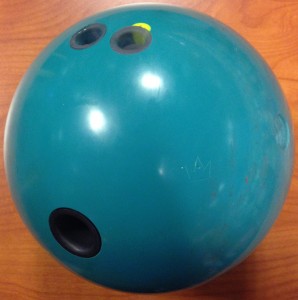
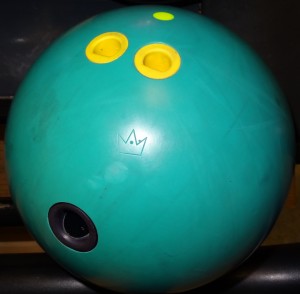
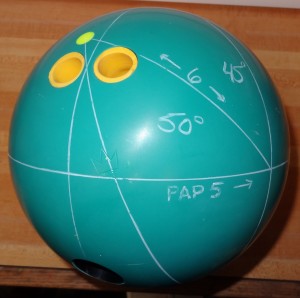
First Impressions
This is going to be a great piece from Brunswick. I like seeing low RG cores still around. Maybe it’s a bit selfish but I love the heavier roll these balls create and the Brunswick Melee Cross is no exception.
Our Testers:
Brandon Hinderer is a PBA Member as well as Brunswick and Vise Staffer.
Power Player: 450 rpm
PAP: 5 3/8 & 7/8 up
Axis tilt: 10-15 degrees
Axis rotation: >45 degrees
Layout: 45 X 4 1/2 X 55
Kerry Smith is a top notch bowler and Brunswick Staffer.
Stroker: 250 rpm
PAP: 5 1/8 & 3/4 up
Axis tilt: 13 degrees
Axis rotation: ~45 degrees
Layout: 50 x 5 x 50
Jeffrey Smith is a Brunswick and Vise Staffer and Co-Owner of Pure It Pro Shop.
Power Player: 450 rpm
PAP: 5 & 0 up
Axis Tilt: 13 degrees
Axis Rotation: 60 degrees
Layout: 50 x 6 x 45
Test Patterns:
41ft THS, 12:1, 26ml
41ft THS, 10:1, 24ml
Keep in mind that coverstock accounts for 70% of ball reaction, but the core creates the dynamic shape of the reaction. Your driller will alter the shape to suit your game.
Value 8.5/10
Sitting in Brunswick’s All-Purpose line, the Melee Cross offers good versatility and good value.
Specs
The Melee Cross uses the Melee Low RG Symmetric core and Savvy Hook Solid Reactive coverstock. This is in contrast to the original Melee which uses a medium RG core and slightly weaker cover. It has an RG of 2.487 and diff of .050. The Melee had a core that looks like a bullet while the Melee Cross looks like a “fat” bullet. Simply put, the Cross offers earlier and smoother roll. The cover is finised with 500 and 2000 Siaair.
Overall
All bowlers found this ball to be on the stronger side of medium. It’s probably on a similar order of strength as the Mastermind Genius but with an earlier and smoother read. Everyone saw a nice smooth motion. The ball starts up a little earlier than the other pieces while creating this backend that seems to get stronger as it continuously punches through the pocket.
For Kerry and Jeffrey, it added a nice amount of control to the slightly heavier house pattern they tested on. Kerry had a great read in her test. The ball just read the pattern and trucked to the pocket. Same thing with Jeff. When the Fortera was a little over/under, the Melee just read every time and punched through the pocket. Even when Jeff got deeper and the ball pushed slightly, it had enough energy to knock all ten down.
Brandon saw a reaction that was quite strong on the medium shot he tested on. There’s no need to take this ball out on a medium condition if you have Brandon’s hand. However, the ball had such a nice read, he can throw it from anywhere on the lane and you can see that in the video.
The Melee Cross is very continuous through the pins. It always seems to read the breakpoint. It rarely blew through the breakpoint. If anything, it can read a little earlier because of it’s intrinsic low RG and rough surface.
Digitrax Analysis
The track above is for Brandon. His “ideal” line on the test lane with the Melee Cross was 20 to 8 at 19mph at release. The breakpoint is 42ft and the ball generated 6 degrees of entry angle. This is one strong ball which gets into a roll quickly. There’s a very clear difference between a heavy rolling ball like the Melee Cross and skid/flip ball like the Fortera Exile. The Melee Cross needs to have the target at the breakpoint a bit further in as it will labor a bit off of too much friction. The early roll also tames down the entry angle to just about ideal angle of 6 degrees.


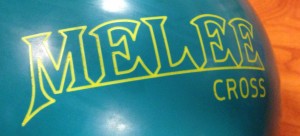
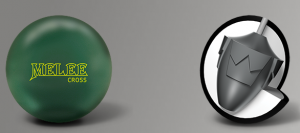
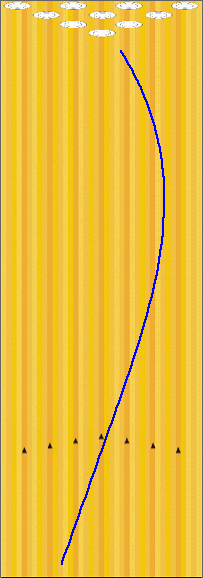
There is very little difference between bowling balls, mainly it’s the bowler. Some hook a little earlier and some a little later.
Hi Hugh. I can understand why it’s easy to feel that way. However, that is grossly inaccurate. While it may look like one ball is only a couple of boards different or breaks a foot sooner or whatever, that could be the difference between shooting 240 and 170. On house shots, it is true that the balls will look similar. That tends to be because the pattern and house dictates the “area” where it scores the best. However, there can be huge variations in that area.
hello,
well it does not seem to matter what ball i throw it hooks so much i can not control any of these reactive balls i have bought scouts,tropical storms, lot of mild cover balls, i am now throwing a super natural .i had the other two naturals also a blue hammer and none of these would carry pins after hitting the pocket in earlier years i have bowled 16 -300 games and 2– 800 series and now do good to avg 150 and about ready to hang them up have bowled for 54 years and do not have any speed left to throw these hooking balls it is now a young man’s game the way they have made all these reactive have made a lot of bowlers better then what they are. i vote go back to the old school lane conditions and the plastic and urethane balls i just had to rag a little bit
thanks
larry
Hi Larry, I hear you. You’re not the first long-time bowler to make such remarks to me. I’m glad to hear you’ve tried several options but of course disappointed for you that you haven’t found an answer. I’m not a big fan of having to drop down to balls like urethane as carry will definitely suffer for those like yourself who need something to simply lay off a bit. I don’t know if you’ve worked closely with a local pro shop on this issue but it is possible that you could use a ball like the Scout, Tropical or LT-48 if you put the right layout on it. You might want to try something where you have a very small drilling angle or a pin that is very close to your PAP. This will start the ball off much closer to the preferred spin axis, allowing the ball to sit.
I truly wish you the best in finding something and not giving up on a game you obviously love.
I tend to agree with Hugh. I believe bowling is about 60% the bowler, 25% the ball coverstock, and 15% the core design. To put it another way, give Pete Weber a plastic ball and he would still average over 200 in most any league in the country.
It’ like guitar playing, no matter what guitar he played SRV always sounded like SRV, and Eric Clapton like himself:)
Upon further thought I should have made the percentage breakdowns:
Bowler: 55%
Ball layout: 20%
Ball coverstock: 15%
Ball Core: 10%